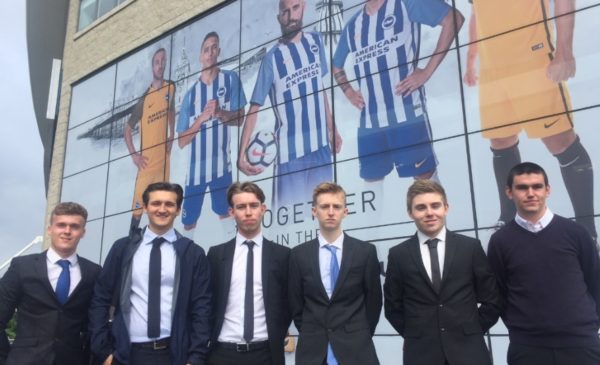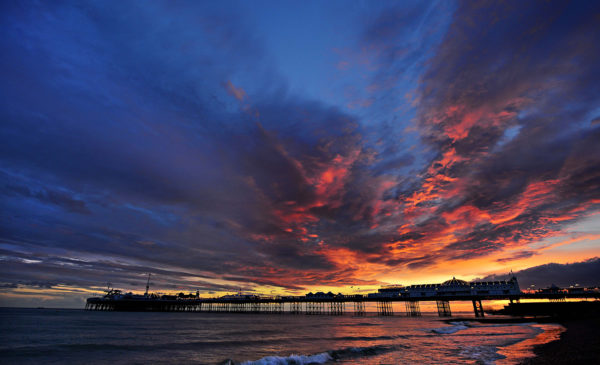It is 6pm on Thursday, May 6, and Queens Park in the centre of Brighton is filled with people of all ages. Countless dog walkers, runners, skaters and cyclists are spotted on the paths that stretch through and around the site. The steep, sloping greens are dotted with small groups of people enjoying picnics in the early evening sunshine. Towards the bottom of the hill, a local kickboxing class is getting into full swing, close to the busy children’s play area where the sound of laughter is almost deafening.
Nestled at the top of this thriving social hotspot, is a queue of people waiting outside the gates of the park tennis courts. Racket cases wrapped around their shoulders and long, slim cans of green felt tennis balls in their hands, everyone from first-time players to club captains can be seen leaving and entering the six courts with smiles on their faces. Despite the wintery temperatures, Queens Park Tennis Club is thriving.
According to the Lawn Tennis Association (LTA), the Queens Park Tennis Club has had the highest court utilisation (75%) of any park club in the London and South East area since 2019. The number of players using the facility in this period (706) was more than double the region average (328), with court bookings (4,933) being 41% higher than any other in the area. Despite courts being closed due to lockdown, grassroots tennis in the UK witnessed a boom period in 2020, nearly 4 million people picked up a racket at least once as participation increased by 8% from 2019.
Park tennis venues, traditionally owned by the council, have moved along way in the past decade. Gone are the days of slippery, moss covered courts with uneven surfaces and faded tramlines. Players are no longer expected to pay their booking fees in cash and the usual hour-long search for a council employee to unlock the gates is a thing of the past.
“When I joined back in 2016, the facility was no longer being properly funded by Brighton and Hove City Council,” said Queens Park’s marketing manager, Conrad Brunner.
In an aim to reduce public spending, the local authority initiated the “self-managed sport facilities” policy in 2016. Encouraging not-for profit organisations or community interest companies (CIC) to take over the ownership of the sports venues and clubs situated in the city’s community parks.
But many within the local tennis community worried that the courts would be sold to the highest bidder. At the time, national companies Freedom Leisure and Virgin Active were suggested to have been interested in making a bid.
“As a club we didn’t like that idea,” Conrad said.
“We thought one day we would turn up and there would be bolts on the gates, meaning we would all have to toe the line for one of these companies. We could have effectively lost control of our club.”
So that year, the club’s committee – which had in its ranks a former Wimbledon media director, an architect, a builder, and a tennis coach – decided to prepare an ownership proposal for the council under the new administration, the Queens Park Tennis Club Community Interest Company. Despite being initially rejected, after a few tweaks to the documentation and a couple of handwritten letters to key councillors later, the club was granted independent status in October 2017.
They have gone from strength to strength ever since. Along with high court utilisation, the number of club members has risen from 70 in 2016, to over 200 in the present day, with an ever-lengthening waiting list. The busy courts have generated £82,000 for the club, which is invested straight back into the facilities. Demonstrated by the recent resurfacing and drainage improvement on two of the courts, costing the venue £35,000. The club has also been a success at youth level, with junior membership increasing by 500% since 2017, with packed groups of young players filling the venue every Saturday and Sunday morning.
“Clubs like Queens Park understand their local community, they know tennis and understand how it runs,” said Matt Glazier, The Participation Development Partner at The LTA for the Sussex and Surrey area.
“They have been able to increase participation compared to what the local authorities would have been able to do.”
Queens Park is not the only successful volunteer-owned club in Brighton. The Hove Park Tennis Alliance also gained ownership of its courts in 2017, and now has over 300 members with a thriving coaching programme. St Ann’s Tennis Club, which only opened as an independent venue in October 2020, already has 120 members. These success stories have meant that the club committees for Hollingbury and Saltdean are now starting the formal process to join the park tennis revolution and release themselves from the shackles of the local authorities.
Abbie Lench – The LTA’s head of clubs, parks, counties and volunteering – said in March this year that councils across the country “don’t realise what sort of assets they have” in their grassroots tennis venues. Many, like Conrad, feel these local government bodies have hurt the sports growth in the past through their lacklustre management of these facilities.: “It’s self-evident a group of concerned individuals are going to care more about a venue then someone sitting in a council office.”
He uses the example of the tennis court “moss crisis” that plagues all Brighton park clubs in February and March each year, to explain his point.
“Everyone would ring the council and ask for them to do a moss treatment, which requires a professional and would cost around £600. They would never fork out the money for that sort of thing.
“So, they would only get treated once every two or three years. Most of them would be as green as a welsh valley and not particularly appealing to any potential players. Now if we want moss treatment, we just order it ourselves, end of.
“That’s just one of many things where it’s much better to oversee your own facility. If there had just been one smart person who understood court and tennis management and worked for the council, they could not only deliver what Queens Park does now at all the clubs but also have brought in a steady revenue stream to the council.”
However, Matt Glazier believes there is “no one size fits all” approach: “I think it depends on the resource of the operator. In other areas of the region and across the country we have local authorities that have the resources to be able to manage and run their park facility.
“But where we’ve got tennis operators and volunteers running clubs, they quite often have more time and knowledge of the sport. They know how to run the facility for tennis, instead of local authorities that have such a broad remit, so there are good examples of both systems being effective.”
This issue is clearly one that is complex, but what both Matt and Conrad can agree is the pivotal role the online booking system – ClubSpark – has had on the sports’ growing popularity.
“It’s the killer thing that makes all of this work. Without the pay and play system using online booking, none of this would be possible,” Conrad explained.
The platform allows LTA registered venues to use their simple online management system free of charge. Meaning that through the club’s website, anyone who fancies a game can see what courts are available at what time. Then in exchange for online payment, players will receive a four-digit pin code that can be used to unlock the court gates at the time of their booking. Not only does this system make it easier for people to book court time, but it is incredibly lucrative for the clubs themselves. Queens Park started to use the system in 2019 and tripled their summer income from the year prior.
Matt believes having this infrastructure is the “key” to being a successful tennis club in the modern world: “We are trying to get as many venues as possible on our online booking system. Not only for the [COVID-19] track and trace regulations and how easy it makes it for our customers, but because it allows clubs to manage their facilities remotely. This is especially helpful for park clubs; they can manage their courts without relying on someone to come and lock and unlock the gates every day.”
The future of grassroots tennis looks incredibly bright and its thanks to the modernising of the park system and the success of volunteer-owned clubs like Queens Park. Last month, the LTA announced a new three-year partnership with ClubSpark, continuing to provide their online service free of charge to all registered venues. The organisation also launched “Rally”, a new free digital platform to help people in deprived areas find and book group coaching sessions, play a match or find free tennis events in their local area.
“Park clubs are an absolute vital resource for British Tennis. There is so much potential for taking them and expanding them so we can provide people with cheap tennis. It’s a great way of bringing people in and broadening the base of participation,” Says Conrad.
“I do believe that our club, as one of the first independent parks clubs in the city, is a good blueprint for other clubs to follow and I hope to see more follow suit in the future.”








